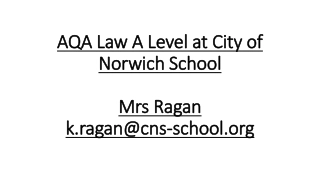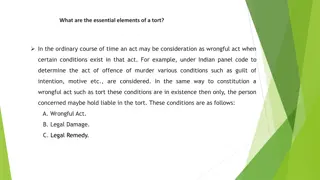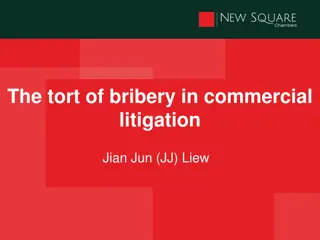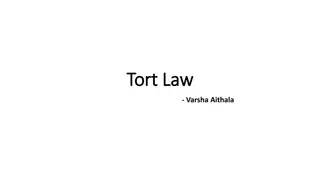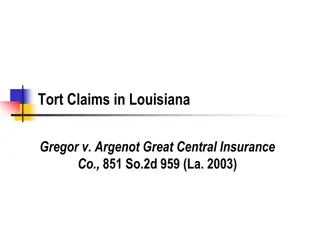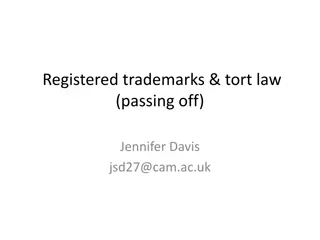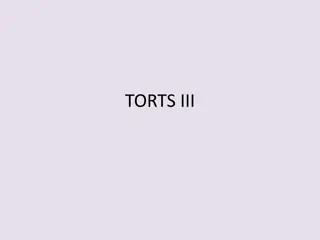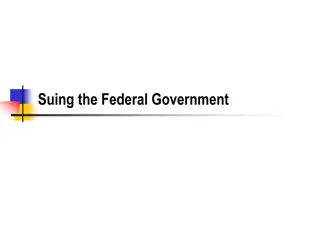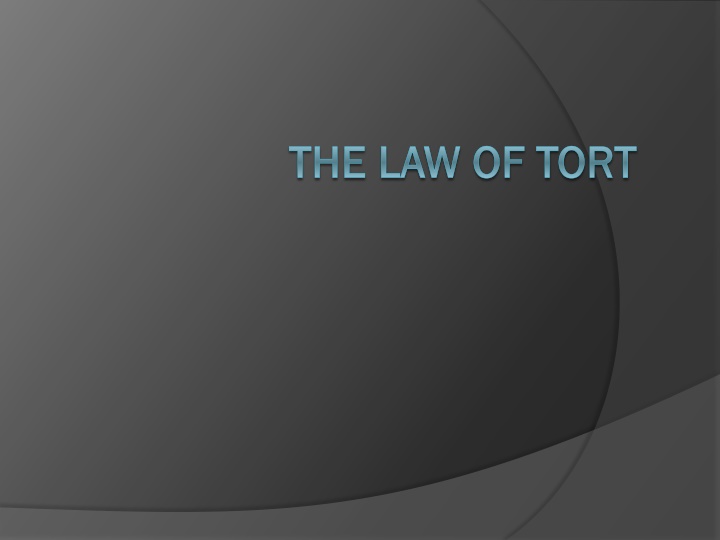
Tort Law: Definition, Categories, and Evolution
Learn about tort law, which defines civil wrongs and legal injuries outside of contract breaches. Explore the categories of torts, such as intentional, negligence, and strict liability, and understand the evolution of tort law over time. Dive into elements of negligence claims, duty and standard of care for professionals, and the implications of negligence in cases involving economic harm.
Download Presentation

Please find below an Image/Link to download the presentation.
The content on the website is provided AS IS for your information and personal use only. It may not be sold, licensed, or shared on other websites without obtaining consent from the author. If you encounter any issues during the download, it is possible that the publisher has removed the file from their server.
You are allowed to download the files provided on this website for personal or commercial use, subject to the condition that they are used lawfully. All files are the property of their respective owners.
The content on the website is provided AS IS for your information and personal use only. It may not be sold, licensed, or shared on other websites without obtaining consent from the author.
E N D
Presentation Transcript
THE LAW OF TORT THE LAW OF TORT
Definition and Purpose of Tort Law A tort is a civil wrong other than a breach of contract Tort law defines what constitutes a legal injury and establishes the circumstances under which one person may be held responsible (i.e., liable) for another s injury
Categories of Torts Intentional torts torts against the person (assault, battery, false imprisonment, intentional infliction of mental suffering, malicious prosecution, libel and slander, and fraud) and property torts (trespass to property, trespass to chattels and conversion) Negligence covers the full scope of human activity (e.g., product liability, slip and fall , negligent misrepresentation, professional negligence, etc.) Strict liability torts nuisance
The Evolution of Tort Law Tort law has evolved over time based on case law Additional torts have also been created by statutes (e.g., occupiers liability, competition law) Perceived failures of the common law to address the needs of society through tort law have led to additional statutory reforms (e.g., workers compensation and negligence legislation)
Elements of a Negligence Claim Duty of care owed by defendant to the plaintiff according to the proximity (i.e., neighbour ) principle Breach of the duty of care by a failure to meet the required standard of care, which is that of the reasonable person in the circumstances Causal link between the defendant s act or omission and the plaintiff s loss (i.e., damages) Damages were reasonably foreseeable at the time of the breach
The Duty and Standard of Care Owed by Professionals Professionals have a duty to exercise the skill, care and diligence that may reasonably be expected of a person (i.e., a professional person in a particular discipline) of ordinary competence, measured by the professional standards of the time
Negligence and Economic Harm Negligence can involve compensable harm that is purely economic in nature This is often, though not exclusively, the situation in cases involving negligent misrepresentation
Defences to Negligence Claims No duty of care owed the duty of care can only arise in circumstances involving reasonably foreseeable harm and proximity sufficient to establish a duty of care and where there are no policy reasons that would negate the establishment of the duty of care No breach of the standard of care No damages were caused by a breach of the standard of care Damages were not reasonably foreseeable Limitation period has expired
Elements of Negligent Misrepresentation Duty of care exists based on a special relationship (e.g., professional person and lay person who may reasonably rely on the professional person s professional expertise) Professional person makes representation that is untrue, inaccurate or misleading The representation is made negligently Person receiving the representation relies on it in a reasonable manner The reliance is detrimental and damages result
Defences to Claims for Negligent Misrepresentation No duty of care is owed (e.g., plaintiff is not a member of the class of individuals that professional knew would rely on the misrepresentation) Plaintiff s reliance is not reasonable (e.g., the representation was part of a discussion and not a formal opinion or the professional limited liability through a disclaimer clause) Professional s negligent misrepresentation did not cause damages Limitation period has expired
Objective of Damages for Commission of Tort To restore the plaintiff to the position he or she would have been in if the tort had not been committed
Damage Awards for Commission of Tort General damages compensation for non-monetary loss or harm suffered as a result of the commission of the tort that was foreseeable when the tort was committed (e.g., pain and suffering, mental distress or damage to reputation) Special damages compensation for the quantifiable monetary losses suffered by the plaintiff that include direct losses (such as amounts the plaintiff had to spend to try to mitigate problems), consequential or economic losses (such as lost profits in a business), and punitive damages, where applicable Punitive damages awarded to punish certain types of behaviour (e.g., fraud or bad faith) Plaintiffs have a duty to mitigate their damages
Vicarious Liability In certain cases, one person can be liable for the harm cause by another One example relevant to professional liability is an employer s liability for the actions or omissions of its employees

